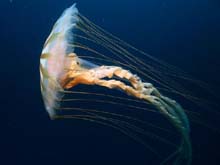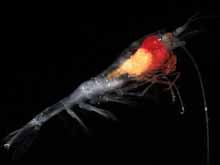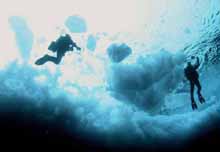
This Chrysaora jelly was spotted on the ROV’s return to the surface. Unfortunately, it was too large to capture with the suction sampler. (Photo courtesy of Kevin Raskoff.) ![]() Watch a video of the first successful ROV sampling and a jellyfish swimming. (Video courtesy of Emory Kristof.) Click image for larger view.
Watch a video of the first successful ROV sampling and a jellyfish swimming. (Video courtesy of Emory Kristof.) Click image for larger view.

The midwater shrimp Hymendora glacialis collected by the ROV during a pelagic dive. (Photo courtesy of Russ Hopcroft.) ![]() Watch a video of the shrimp's capture and a jellyfish swimming. (Video courtesy of Emory Kristof.) Click image for larger view.
Watch a video of the shrimp's capture and a jellyfish swimming. (Video courtesy of Emory Kristof.) Click image for larger view.

The ROV captured this image of the sea ice ecological group divers silhouetted against the sea surface. (Photo courtesy of Emory Kristof.) Click image for larger view.
Pelagic ROV Dive
August 22, 2002
Russ Hopcroft
University of Alaska Fairbanks
![]() Watch a video of the first successful ROV sampling and a jellyfish swimming. (mp4, 1.9 MB)
Watch a video of the first successful ROV sampling and a jellyfish swimming. (mp4, 1.9 MB)
![]() Watch a video of the first launch of the ROV Global Explorer. (mp4, 3.3 MB)
Watch a video of the first launch of the ROV Global Explorer. (mp4, 3.3 MB)
There was a flurry of activity on the foredeck. The hatch cover folded open, and the crane swung to lift the remotely operated vehicle (ROV) from the forward hold. Finally, after several delays and brief test dives, the ROV was prepped and dropped into the water for its first operational dive at 10:00 am.
The diving machine descended quickly through the zone bathed in surface life. We watched intensely on special monitors as smaller zooplankton, mostly copepods, and marine snow swirled past the cameras. By 200 meters depth, only the lights of the ROV were seen by the camera. Compared to the waters in which our team had dived previously, we were surprised by the apparent lack of larger gelatinous zooplankton. The occasional small jellyfish (1-2 cm) dashed by close to the camera, but we were unable to stop and relocate any of them. We continued to search as we dropped deeper and deeper into the basin. The occasional deep-water shrimp and larvaceans soon made our observation list.
We tried repeatedly to stop near organisms in the 1-3 cm size range for pictures. It soon became clear that there would be insurmountable difficulties in observing or collecting these and other animals. Although the ROV was performing superbly for its first dive, we were “flying-blind” in terms of our position at depth.
Normally during a dive, the ROV and the ship are aware of each other’s position through a navigation system that relies on an acoustic transducer and receiver (effectively an underwater directional microphone). It had been impossible to install such a system for these dives, in part due to the difficulties of deployment from an icebreaker, and in part due to the large size of the transducers that would be required to work at the great depths planned for the dives. To further complicate matters, our closeness to the north magnetic pole had rendered the compass on the ROV unreliable. A compass is critical to the ROV pilot’s ability to know where he is relative to the cable that connects it to the ship. Without knowing direction, the pilot is unable to know if the ROV is slowly turning, putting twists into the cable that can lead to sharp bends or kinks that damage the tether. Despite the best efforts by the ROV pilot and the ship’s captain, every time we tried to stop, we were soon being pulled away like a sniffing dog on a leash.
We endured these unfortunate limitations and continued downward, constantly keeping the tether in sight of the camera. Three and one-half hours into the dive, we reached the ROV’s maximum operating depth of 2760 m (9000 feet). We searched near this depth for over an hour, but found little. We began the slow climb back toward the surface as the tether was wound back onto the winch. Along the way, we made a lucky catch of one small mid-water shrimp with the suction sampler. This animal would be the only specimen collected during the dive.We reached the near-surface waters at 6:00 pm, and, ironically, made our first observation of a larger jellyfish. This Chrysaora was actually too large for us to collect. It would have clogged the nozzle of the suction sampler. Numerous smaller ctenophores appeared to exist in layers several meters below the ice. We decided to explore these shallow waters and began to head under the ice. The scuba divers could be seen nearby, and they scrambled to photograph the ROV. The bottom of the ice was a complex honeycomb, with light spilling through in unpredictable beauty. Unfortunately, we had only minutes beneath the ice before the ship and weight of the tether cable began to drag us out into open water. The dive ended at 7:00 pm, followed by much rejoicing over this first exciting glimpse into the ocean depths.
Sign up for the Ocean Explorer E-mail Update List.


























